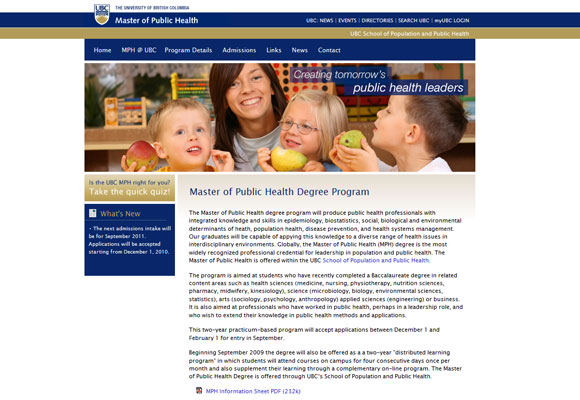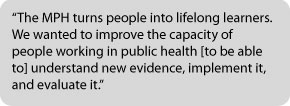 Recognized for its leadership in population and public health, the UBC Master of Public Health (MPH), recently made the foray into distributed learning. Offered within the School of Population and Public Health, the two-year program offers both traditional (on-campus) and distributed learning (on-campus and online) study options for students. UBC’s MPH program is unique in that no other MPH program in Canada offers a distributed learning option. I recently sat down with Dr. Patti Janssen, the Director of the Master of Public Health Program and a 2009/2010 UBC Killam Teaching Prize recipient, to discuss the Centre for Teaching, Learning and Technology’s involvement in the course development process, as well as her experience teaching in the MPH program.
Recognized for its leadership in population and public health, the UBC Master of Public Health (MPH), recently made the foray into distributed learning. Offered within the School of Population and Public Health, the two-year program offers both traditional (on-campus) and distributed learning (on-campus and online) study options for students. UBC’s MPH program is unique in that no other MPH program in Canada offers a distributed learning option. I recently sat down with Dr. Patti Janssen, the Director of the Master of Public Health Program and a 2009/2010 UBC Killam Teaching Prize recipient, to discuss the Centre for Teaching, Learning and Technology’s involvement in the course development process, as well as her experience teaching in the MPH program.
The Distributed Learning Format
Dr. Janssen was quick to point out that the distributed learning format, first offered in September 2009, includes key on-campus components. Students are required to spend 70% of their time on-campus and 30% of their time online. The on-campus component consists of four full-day classes held each month (on Thursday, Friday, Saturday, and Sunday), and these occur three times per term. The MPH program also makes an effort to schedule events when the distributed learning students are in town, so that they can meet other MPH students.
The distributed learning format is designed to “make it [the MPH] accessible to working health professionals,” notes Dr. Janssen. She also revealed that the “regional health authorities have supported the program in that students who are employees continue to receive their salaries on the Thursday and Friday, and complete the Saturday and Sunday classes on their own time.” With increased flexibility offered through the distributed learning format, UBC’s MPH program has attracted students from Ontario, Alberta, the Yukon, and all over British Columbia. The program is also recognized internationally, with students coming from Europe, Africa, and Asia to take the MPH in the traditional format.
Course Development
Dr. Janssen consulted the Centre for Teaching, Learning and Technology (CTLT) before she began the development of the distributed learning format. Jeff Miller, Senior Manager of Distance Learning at CTLT, first met with Dr. Janssen to discuss the possibilities of moving some of the content online. Dr. Janssen then worked closely with Brian Wilson, an Instructional Designer / Project Manager at CTLT, in 2008 to begin the course development process for the online components of the distributed learning courses. The development process involved Brian becoming familiar with the course content and suggesting what learning modalities would fit with the content. For example, for Dr. Janssen, it was important to know that she could “use Wimba Classroom to write equations,” as her Epidemiology course involves complex equations and calculations.
Through TLEF funding, the MPH program was also able to hire Teaching Assistants (TA’s). The TA’s “helped to choose the tools used and the way the content was presented,” explains Dr. Janssen, and they played a key role in the course development process. Initially, some instructors were concerned that they did not have the programming knowledge to put together an online course. With the help of the TA’s and Brian, as well as the web programming and graphic design work from CTLT’s Joseph Khalil and Gabriel Lascu, the instructors did not need to learn any web programming and could focus on the content and pedagogy of the course.
Teaching in the MPH
 The 2009/2010 Killam Teaching Prize was awarded to Dr. Janssen due in large part for her work in the MPH program. In addition to being the Director of the program, she is an instructor for two of the courses: SPPH 502 Epidemiological Methods (distributed learning) and SPPH 537 Perinatal Epidemiology (on-campus). The Killam Teaching Prize is awarded annually to faculty who demonstrate excellence in teaching. The interesting thing about this honour is that Dr. Janssen sees herself first and foremost as a clinician and researcher. Having taught at UBC since 2002, Dr. Janssen uses her clinical background to “take real data and show how it can be applied to real life situations.” She often shares stories from her clinical practice, for example, telling students about “what happens when a clinician doesn’t understand the difference between blinding and using a placebo drug.” Such examples work well with the students and allow them to grasp the material better, as they can often relate their studies to these real life work experiences.
The 2009/2010 Killam Teaching Prize was awarded to Dr. Janssen due in large part for her work in the MPH program. In addition to being the Director of the program, she is an instructor for two of the courses: SPPH 502 Epidemiological Methods (distributed learning) and SPPH 537 Perinatal Epidemiology (on-campus). The Killam Teaching Prize is awarded annually to faculty who demonstrate excellence in teaching. The interesting thing about this honour is that Dr. Janssen sees herself first and foremost as a clinician and researcher. Having taught at UBC since 2002, Dr. Janssen uses her clinical background to “take real data and show how it can be applied to real life situations.” She often shares stories from her clinical practice, for example, telling students about “what happens when a clinician doesn’t understand the difference between blinding and using a placebo drug.” Such examples work well with the students and allow them to grasp the material better, as they can often relate their studies to these real life work experiences.
Dr. Janssen uses Wimba Classroom extensively for the online portion of her Epidemiological Methods course. She holds online tutorials twice a week, one during the evening and one during the weekend to accommodate the working professionals in her class. She champions the benefits of using Wimba Classroom, as both she and the students are able to see and hear one another. Dr. Janssen can also share her PowerPoint with the students and write on the presentation, something which she finds “extremely useful when going through calculations.”
All of the exams in Dr. Janssen’s course are held online. “Students must log onto the course website and start the exam at a certain time, and they only have three hours to complete the exam,” she explains. When the students are finished, they can either upload the exam to the WebCT Vista course page, or fax it to Dr. Janssen, who stays in her office during this time and encourages students to call her if they have any issues.
In addition to using Wimba Classroom, some instructors in the MPH program take advantage of other online technologies, posting content to wikis, uploading PDF files and videos online, and encouraging students to use the discussion forum in WebCT Vista. Sometimes, if there is a guest speaker, the audio and PowerPoint presentation is recorded and posted online for students to view.
 So far, the MPH has developed 10 distributed learning courses, with five more rolling out in September 2010. Dr. Janssen was quick to note that the distributed learning courses are “open to the whole School of Population and Public Health,” and that students outside of the MPH program can take these courses. This has been a particularly good fit with students in the Community Medicine Residency program, as they often complete work placements outside of the Lower Mainland and don’t have the time to take an on-campus course.
So far, the MPH has developed 10 distributed learning courses, with five more rolling out in September 2010. Dr. Janssen was quick to note that the distributed learning courses are “open to the whole School of Population and Public Health,” and that students outside of the MPH program can take these courses. This has been a particularly good fit with students in the Community Medicine Residency program, as they often complete work placements outside of the Lower Mainland and don’t have the time to take an on-campus course.
Dr. Janssen notes that the MPH program includes students who are “doctors, physiotherapists, pharmacists, nurses, food and safety inspectors, and veterinarians,” to name a few, and that the program is “very interdisciplinary”. In fact, the program includes most of the required courses for a PhD, and students can further their education by pursuing a PhD after they complete the MPH.
When asked about the importance of the MPH program, Dr. Janssen highlighted the fact that it “turns people into lifelong learners.” The MPH instills the notion that there is a “continuous process of innovation and evaluation” in the public health field. Dr. Janssen notes that “we wanted to improve the capacity of people working in public health [to be able to] understand new evidence, implement it, and evaluate it.”
The MPH has proven to be quite popular, and with the development of new courses for the upcoming year, it looks to keep growing. During the last intake session, there were 360 applications for only 36 spots in the program (18 spots each in the traditional and distributed learning formats). With the continued development of high quality courses, and with instructors like Dr. Janssen, the MPH program at UBC should continue to benefit working health professionals for years to come.


http://www.spph.ubc.ca/?p2=modules/blog/viewcomments.jsp&bid=74
This has to be one of the most brilliant ideas. I want to know what is the best road to take in obtaining a MPH. I only have two years of college completed, in courses such as Business Management, accounting, and travel and tourism. Please send your feedback because I would like to do something this coming school year. Also I am 34yr with 4 children, so my time is limited. Please reply. thank you
Hi Rohan,
Thanks for your message and interest in the MPH program.
The MPH program would be best situated to answer your questions, and they can be reached here: http://www.mph.spph.ubc.ca/contact.html
Cheers,
Michael